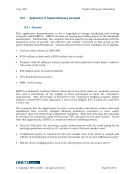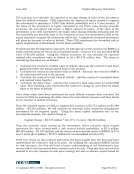June 2007 Capital Adequacy Extension © Copyright 2007, CCRO. All rights reserved. Page 4 of 92 1.3. Adequacy for Economic Value Measurement of Capital Adequacy requires an assessment of the relative size of the firm’s equity versus its Risk Capital Requirement. To the extent that a firm has adequate equity to cover its risks, the firm may enjoy greater confidence in its ability to cover the threats to value creation that it faces from different sources (market, credit, operative, and business risks). 1.3.1. A Word On the Challenge of Accounting Equity Measures Measuring risks within the energy industry is a complex task in itself measuring a firm’s economic equity, while on the surface fairly straightforward, can prove to be a difficult exercise. The use of financial statement data presented under Generally Accepted Accounting Principles (GAAP) may not provide a clear & robust picture of an energy company’s economic equity. Fallout from the energy merchant failures of 2000-2002 included a dramatic reduction in the use of fair market value, or mark-to- market, accounting. While this paper does not take a stance on the merits of the current or previous accounting guidelines for energy firms, there is agreement across the industry that GAAP financial data often does not provide a clear picture of the value of energy business operations. One result of this recognized mis-match between accounting values and market value is that more energy companies are now supplementing their GAAP financial statements with “economic” financial statements. This economic data incorporates fair market valuation for a portion of the firm’s assets and liabilities and may be a more accurate measure of the value of a company’s equity component. Firm’s will have to evaluate whether to rely on the GAAP generated traditional balance sheet versus an economic balance sheet in determining equity. It is important to note that more stakeholders are demanding economic financial statements in order to get a better understanding of energy companies’ financial health & performance. In addition to the above discussion on this issue, a number of CCRO companies have found in the past that the differences between GAAP and internally generated economic balance sheets often provide material for constructive internal debates. These debates in turn often lead to a much better understanding by company managers of the issues and risks faced by the company. Thus, the capital adequacy frameworks detailed herein often lead to much improved decision making - even if the numbers generated are a cause for internal debate. 1.4. Economic Capital and the Four Categories of Risk Capital adequacy assessments require a measure of risk capital – aka the “Economic Capital” created by the business activities conducted by the firm Risks are first
Purchased by unknown, nofirst nolast From: CCRO Library (library.ccro.org)




























































































